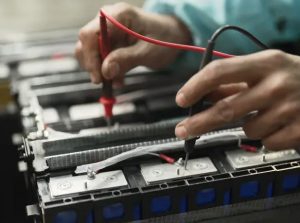Neuron Energy is set to achieve a major milestone this year with the launch of its advanced lithium-ion battery manufacturing facility in Chakan, Pune. Spanning five acres, the plant is designed with an annual production capacity of 1.5 GWh to meet the rising demand for high-performance batteries across electric two- and three-wheelers, drones, and energy storage systems, shares Pratik Kamdar, CEO & Co-Founder of Neuron Energy in an interview with EVolution Auto India.

Q: Neuron Energy specialises in sustainable energy solutions for electric mobility and energy storage. Please tell us in brief about your journey and product portfolio.
Pratik Kamdar: Neuron Energy was founded in 2018 with a vision to reshape India’s electric mobility and energy storage landscape through innovative, locally developed solutions. We began with lead-acid batteries for electric two- and three-wheelers and quickly evolved with market needs.
Today, our portfolio includes advanced lithium-ion batteries for EVs, drones, UPS applications, and energy storage systems (ESS). Our growth is fueled by a commitment to quality, safety, and customization. We work closely with OEMs to co-develop battery packs equipped with sophisticated Battery Management Systems (BMS) and high-performance cells.
Neuron Energy is now a trusted name in EV batteries, especially in the L5 segment, with successful integrations across a variety of powertrain platforms. We also offer EV chargers and turnkey energy storage solutions, and are investing in next-gen technologies like solid-state and sodium-ion batteries. At our core, we’re driven by sustainability—reducing India’s dependence on fossil fuels and building an energy-resilient future.
Q: Earlier this year, Neuron Energy unveiled its lithium-ion battery manufacturing facility with an annual output of 1.5 GWh. Tell us more about the facility, along with the in-house technologies.
Pratik Kamdar: Neuron Energy is set to achieve a major milestone this year with the launch of its advanced lithium-ion battery manufacturing facility in Chakan, Pune. Spanning five acres, the plant is designed with an annual production capacity of 1.5 GWh to meet the rising demand for high-performance batteries across electric two- and three-wheelers, drones, and energy storage systems. The facility will feature fully automated assembly lines and rigorous quality control systems to ensure top-tier reliability and safety.
At the heart of the facility will be a 6,500 sq. ft. experience centre for OEMs and partners to engage directly with our innovations, alongside a 5,000 sq. ft. R&D centre dedicated to developing next-generation technologies—including solid-state batteries, hybrid chemistries, and intelligent Battery Management Systems. This facility represents more than just expansion—it marks our long-term vision to make India a global leader in sustainable energy and clean mobility.
Q: The battery supply chain is the backbone of the EV revolution. How, according to you, can a more localised, secure, and sustainable supply chain be built in India?
Pratik Kamdar: Building a robust, localised, and sustainable battery supply chain is crucial for India’s EV revolution. To achieve this, we need to move beyond simply assembling battery packs and invest in developing capabilities in cell manufacturing, as well as upstream components like cathodes and anodes. While initiatives like the PLI scheme have laid a solid foundation, long-term success will require deeper investments in raw material processing and innovation in alternative chemistries such as sodium-ion and aluminium-air.
At Neuron Energy, we’re focused on localising our operations and collaborating with technology innovators to build a self-reliant EV ecosystem. Strengthening India’s raw material supply and fostering industry partnerships will be key in ensuring the future of clean mobility. By addressing these challenges, we can create a sustainable and secure supply chain that is crucial to India’s energy transition and its global competitiveness in the EV sector.
Q: India currently lacks a large-scale, standardised EV battery recycling infrastructure. What are the most urgent gaps that need addressing, and how can Neuron collaborate in this space?
Pratik Kamdar: Battery recycling is an overlooked but crucial aspect of India’s EV ecosystem. As EV adoption accelerates, we’ll soon face a surge in end-of-life batteries, which can pose environmental risks if not handled properly. Currently, the recycling process in India is fragmented and lacks standardisation, leading to inefficient collection, disposal, and recycling. A major gap lies in technology; most existing systems focus on basic dismantling, with limited capability to recover valuable materials like lithium, cobalt, and nickel.
Without advanced recovery processes, we miss the opportunity to create a circular economy, which could reduce costs and environmental impact. At Neuron Energy, we see this challenge as an opportunity to lead by collaborating with clean-tech startups and recycling partners. Together, we can create a connected ecosystem where battery manufacturers, OEMS, and recyclers form a transparent, closed-loop supply chain. Policy initiatives like Extended Producer Responsibility (EPR) are a step forward, but implementation must be consistent across states to drive real change.
Q: From your vantage point as a battery tech innovator, how aligned are India’s EV policies with areas like battery manufacturing, charging infrastructure, and end-user adoption? Do you think India can meet its EV targets by 2030?

Pratik Kamdar: India has made significant strides in promoting EV adoption, with policies like FAME II, the PLI scheme for Advanced Chemistry Cells, and incentives for charging infrastructure. However, the integration of policy, infrastructure, and consumer adoption is still evolving. While manufacturing has gained momentum, particularly with local production scaling up, we continue to rely heavily on imports for raw materials and cell technology.
To truly become self-reliant, India must strengthen upstream innovation and secure the supply of critical raw materials. Charging infrastructure is improving, but rural and semi-urban areas require more attention. The development of standardised, interoperable systems and stronger public-private collaborations will be essential.
On the consumer front, affordability, range anxiety, and infrastructure gaps remain significant challenges. Targeted subsidies, better financing, and scrappage policies can help overcome these hurdles. While India’s 2030 EV targets are ambitious, they are achievable with coordinated efforts from all stakeholders, positioning India to lead the global shift toward sustainable mobility.
Q: Lastly, as someone at the forefront of India’s energy transition, what excites you most about the future of electric mobility—and where do you see Neuron Energy in this bigger picture five years from now?
Pratik Kamdar: The future of electric mobility is full of potential—and Neuron Energy is poised to be at the center of it. In the next five years, we aim to evolve into a fully integrated energy company, covering cell development, battery packs, energy storage, and recycling. Our priority will be to deliver high-performance, sustainable, and future-ready battery solutions.
From next-gen chemistries to AI-driven Battery Management Systems and strong OEM partnerships, we are committed to powering India’s clean energy future. The convergence of innovation and sustainability presents a pivotal opportunity for Neuron Energy. We see ourselves at the core of India’s energy transition—delivering solutions that fuel the EV revolution and help build a self-reliant, sustainable future.